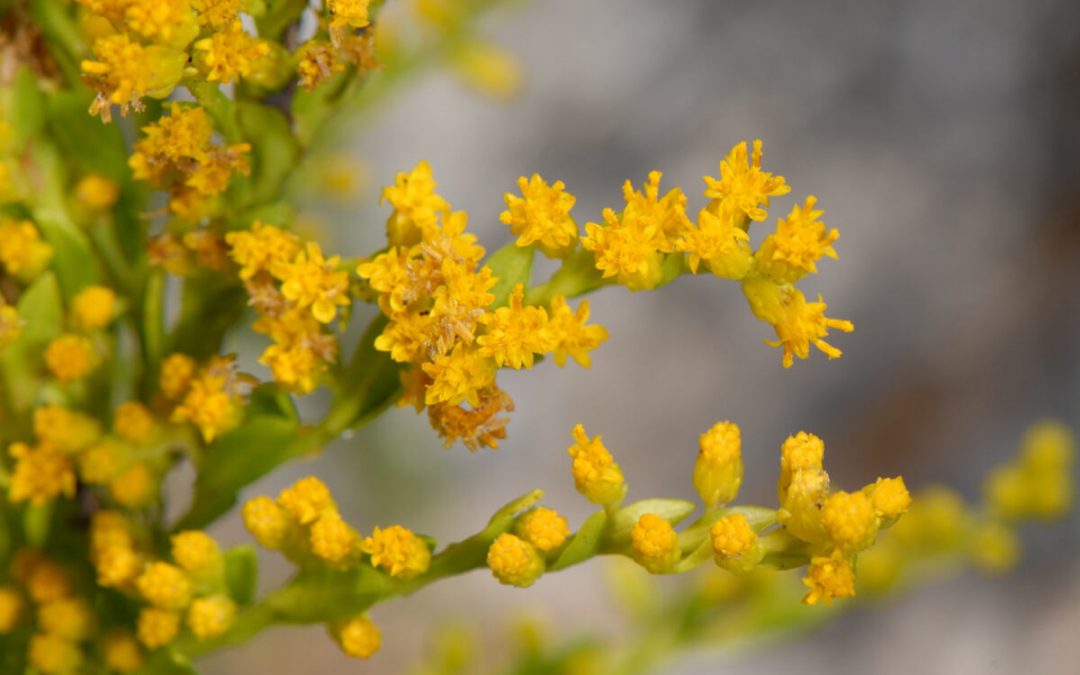Tampa Bay’s subtropical climate and coastal location provide the perfect conditions for many beautiful native plants to thrive right in your front yard (and backyard). Planting native plants is the perfect way to add a touch of Florida to your Tampa landscape. There are several reasons homeowners should consider installing native plants:
- Native plants are accustomed to Floridia soil.
- They promote a diverse ecosystem by supplying local wildlife with food and shelter.
- These plants are usually hurricane resistant.
- Native plants are low-maintenance and capable of thriving on their own.
- They usually don’t need much fertilizer or chemicals, making them eco-friendly.
From tropical palms to beautiful wildflowers, native plants have grown in the Tampa Bay area’s subtropical climate for hundreds of years and are well-adapted to the conditions.
In this article, we’ll cover:
- American Beautyberry (Callicarpa americana)
- Bald Cypress (Taxodium disitchum)
- Butterfly Weed (Asclepias tuberosa)
- Firebush (Hamelia patens)
- Gloriosa Lily (Gloriosa superba)
- Gumbo-Limbo (Bursera simaruba)
- Sabal Palm (Sabal palmetto)
- Scarlet Hibiscus (Hibiscus coccineus)
- Sea Grape (Coccoloba uvifera)
- Sea-oxeye Daisy (Borrichia Frutescens)
- Seaside Goldenrod (Solidago sempervirens)
- Spiked Blazing Flower (Liatris spicata)
- How to Choose the Best Tampa Natives for Your Landscape
- FAQs About Best Native Plants for Tampa
- Where to Find Native Plants in Tampa
12 Best Native Plants for Tampa
1. American Beautyberry (Callicarpa Americana)
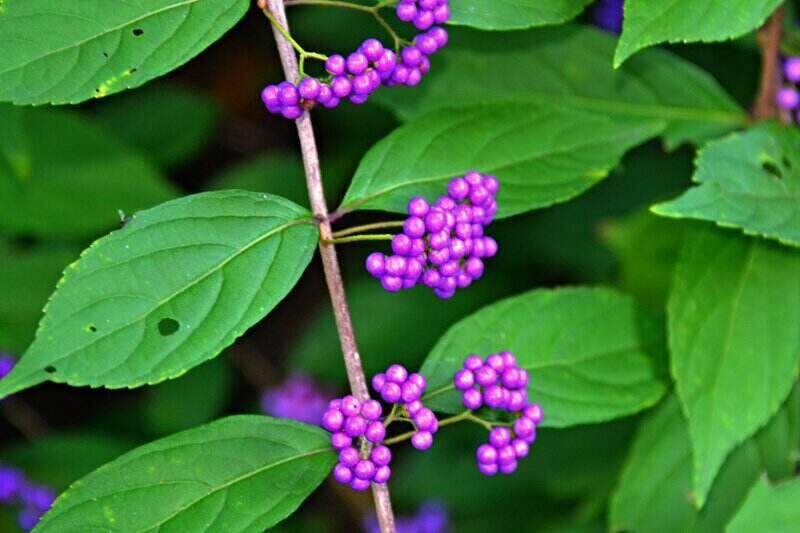
Photo Credit: Tony Alter / Flickr / CC BY 2.0
American beautyberry, also called French mulberry, features large leaves and arching stems full of either flowers or berries, depending on the time of year. Once late summer hits, the flowers mature into bright violet berries that last until fall and sometimes into winter. The berries grow in multiple clusters along the woody stem, spaced out along the vine like veggies on a kabob.
Although the berries are edible, they are not known for being particularly tasty, though they are sometimes used to make jelly. Birds enjoy snacking on the raw berries. Beautyberry flowers are white, pink, or lavender, and their nectar attracts bees and butterflies in spring and summer.
Growing at forest edges, American beautyberry loves sunlight, though it thrives best with regular hydration.
The serrated leaves of beautyberry are broad, perfect for sheltering small wildlife. When crushed, the leaves have a pleasant aroma that wards off mosquitoes. Rubbing crushed leaves on your skin can act as a natural mosquito repellent.
Growth habit: Shrub
USDA hardiness zone: 6-11
Mature size: 3-9 feet tall and 3-8 feet wide
Duration: Perennial
Foliage: Deciduous
Sunlight needs: Full or partial sun
Soil preferences: Loamy, sandy, chalk, clay, acidic, well-drained
Water needs: Low.
Salt tolerance: Low.
Wind resistance: Moderate
Potential hazards: Non-toxic; berries are edible
2. Bald Cypress (Taxodium disitchum)
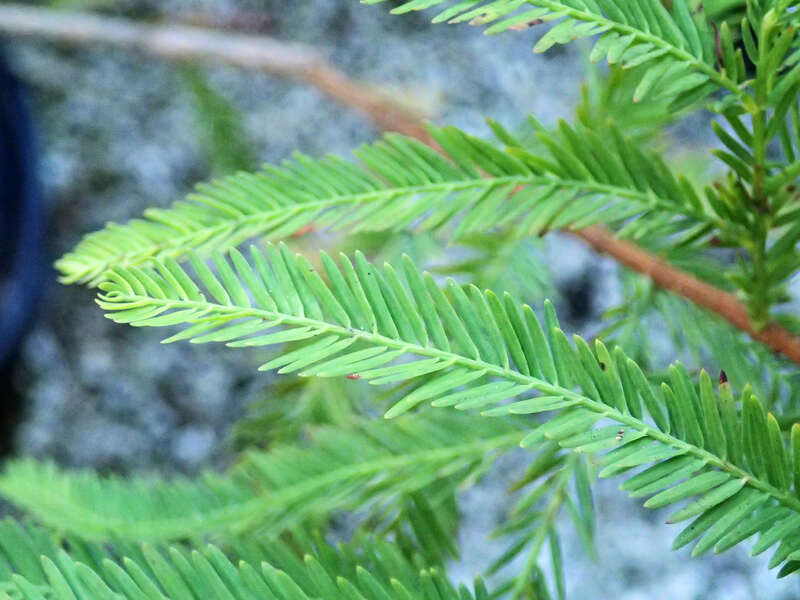
Photo Credit: James St. John / Flickr / CC BY 2.0
The bald cypress is a water-loving tree that can survive being submerged in water for long periods of time. Because of their affinity for water, bald cypresses are typically found in swampy areas or growing near streams and rivers.
With delicate fern-shaped leaves and peeling silver bark, bald cypresses are just as beautiful in the summer months as they are in the autumn when the leaves change to a colorful blaze of burnt orange. Bald cypresses produce cones full of seeds that make a nice snack for birds, squirrels, and other small critters.
With a lifespan that would make even Grandmother Willow jealous, bald cypresses live for a very long time, up to 600 years.
Growth habit: Confier
USDA hardiness zone: 4-9
Mature size: 50-100 feet
Duration: Perennial
Foliage: Deciduous
Sunlight needs: Full sun, partial shade
Soil preferences: Sandy or loamy soils; adapts well to a wide range of soil pH
Water needs: Low
Salt tolerance: Moderate
Wind resistance: High
Potential hazards: Might cause mild allergic reactions
3. Butterfly Weed (Asclepias tuberosa)
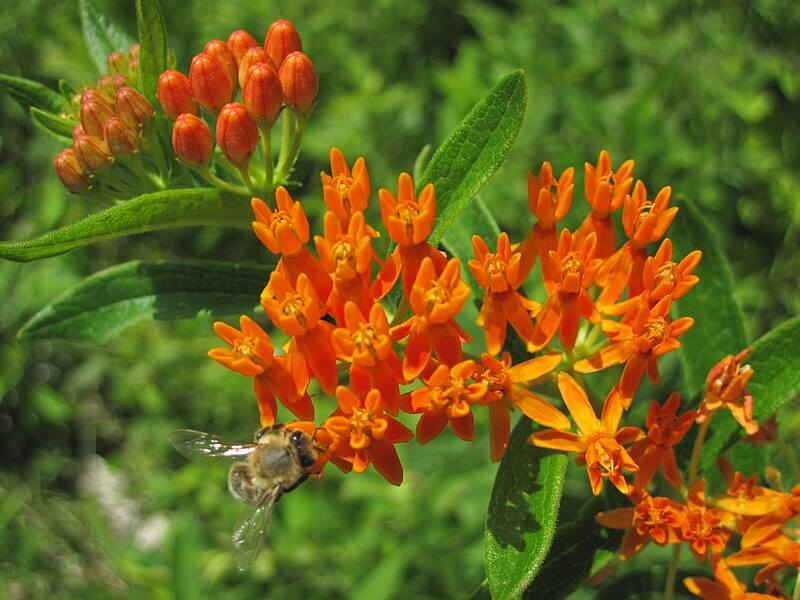
Photo Credit: James St. John / Wikimedia Commons / CC BY 2.0
For Tampa residents looking to add a splash of vivid color to their landscape, butterfly weed produces a blaze of star-shaped flowers. The tiny flowers grow in clusters of orange, although sometimes they come in red or yellow hues. Their hairy stems stand erect, crowned with lush flower blossoms. The stems are populated with long, thin leaves that are a rich green color.
As one might guess, one of the most delightful aspects of butterfly weed is its ability to attract butterflies to your yard. Monarch butterflies are attracted to butterfly weed, which is a host for butterfly eggs. Their pollen and nectar attract bees and hummingbirds, as well. Unlike most milkweed types, the sap of butterfly weeds is translucent and doesn’t irritate the skin.
Butterfly weed grows in fields and prairies throughout Hillsborough County. The drought-tolerant plant can take a while to get established. Sometimes it can take up to three years until it starts to flower during late summer and early fall.
Growth habit: Wildflower
USDA hardiness zone: 3-9
Mature size: 1-3 feet tall
Duration: Perennial
Foliage: Herbaceous
Sunlight needs: Full sun
Soil preferences: Well-drained, dry, rocky, loamy, sandy, and clay
Water needs: Low
Salt tolerance: Moderate
Wind resistance: Moderate
Potential hazards: Toxic to dogs, cats, and horses
4. Firebush (Hamelia patens)
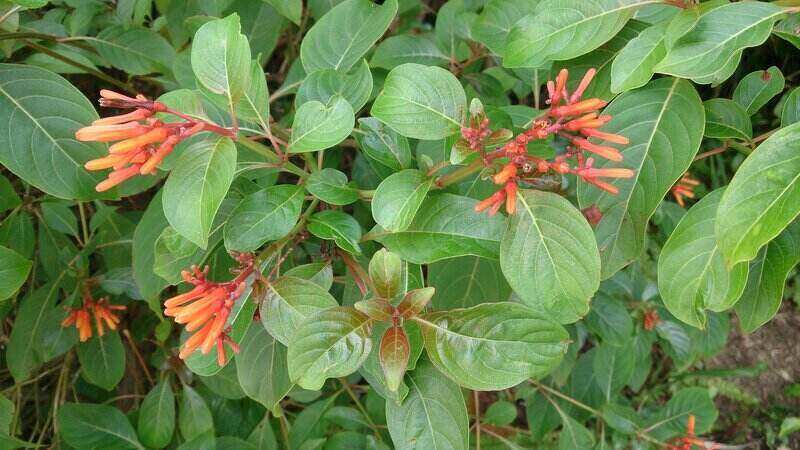
Photo Credit: Mokki / Wikimedia Commons / CC BY-SA 3.0
A favorite for hummingbirds and butterflies, firebush produces tubular flowers from spring through fall. Their flowers look like a cluster of tiny hot peppers, blending shades of orange, yellow, and red to add a fiery flare of color to any yard.
Nicknamed the scarlet bush, firebush is a behemoth of yard plants, adding bushy vegetation that can grow up to 15 feet tall. Homeowners love these bushes for their resistance to hurricanes, making them a suitable fit for hurricane-prone Tampa.
Firebush flourishes in South Florida. These plants tolerate a wide range of soils and aren’t the pickiest about where they settle down. Small mammals and birds love snacking on the black berries. The leaves of a firebush possess medicinal properties for healing bug bites, fungal infections, and rashes.
Growth habit: Shrub
USDA hardiness zone: 8-11
Mature size: 5-15 feet tall and 2-6 feet wide
Duration: Perennial
Foliage: Evergreen
Sunlight needs: Full sun; needs at least 6-8 hours of sunlight a day
Soil preferences: Well-drained, sandy, loamy, slightly alkaline soil
Water needs: Moderate
Salt tolerance: Moderate
Wind resistance: High.
Potential hazards: Not toxic; berries are edible
5. Gloriosa Lily (Gloriosa superb)
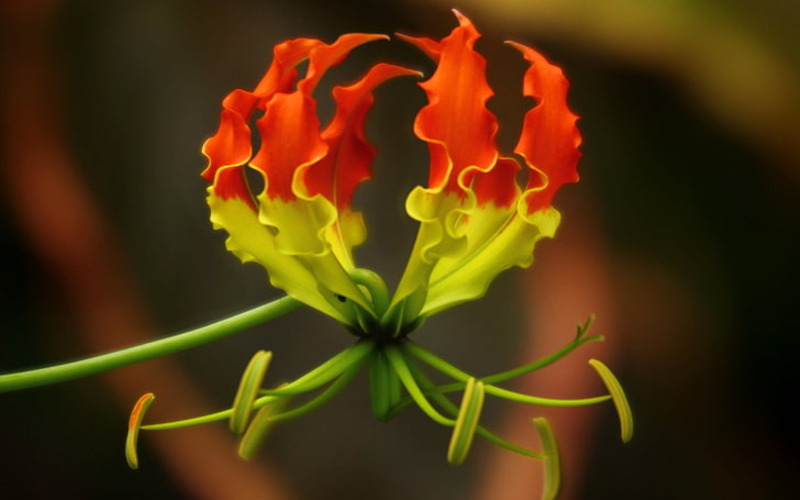
Photo Credit: Wallpaperflare
Like a blaze of fire, the gloriosa lily blooms in a rich medley of curling red petals trimmed with yellow. The plant originated in Africa and Asia. The gloriosa lily is a boon to butterflies and bees, who love to visit its sweet-smelling flowers. The beauty and unusual shape of this lily has earned it many nicknames:
- Cat’s claw
- Climbing lily
- Creeping lily
- Fire lily
- Flame lily
- Flame-of-the-Wood
- Glory flower
- Glory lily
- Superb lily
- Tiger’s claw
A type of bulb, gloriosa lilies have tubers for their root system. The plant is a climber with vine-like tendrils that creep upward, making it a great plant for trellises or chain-link fences.
Despite the name, gloriosa lilies are not actually lilies. The flame lily can last for decades. A gloriosa lily should be placed in a part of the yard where it can get 6-8 hours of sunlight exposure a day. Gloriosa lilies need rich, well-drained soil.
Growth habit: Bulb
USDA hardiness zone: 8-11
Mature size: 4-6 feet tall and 1-3 feet wide
Duration: Perennial
Foliage: Deciduous
Sunlight needs: Full sun or partial shade
Soil preferences: Well-drained, acidic, alkaline, neutral, loamy, or sandy soils
Water needs: Moderate
Salt tolerance: Low; does not tolerate salt
Wind resistance: Low
Potential hazards: Poisonous to people, dogs, cats, squirrels, and horses; tubers can irritate skin
6. Gumbo-Limbo (Bursera simaruba)
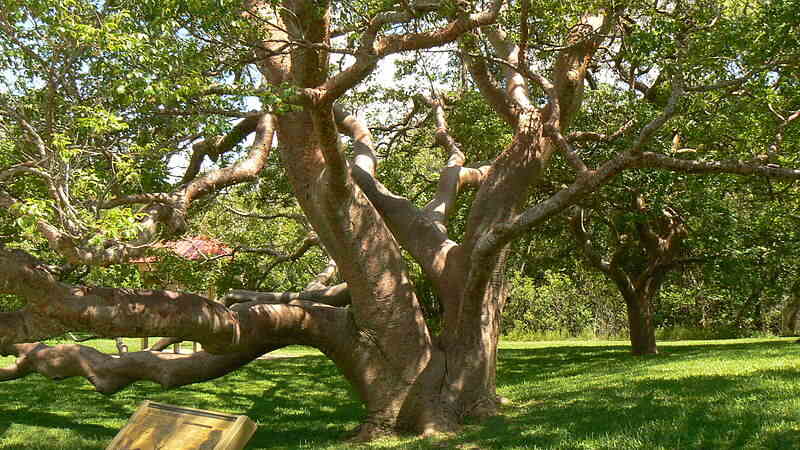
Photo Credit: Milo44 / Wikimedia Commons / CC BY-SA 3.0
Before plastic became commonplace, the lightweight wood of gumbo-limbo trees was used for making horses in carousels. With a century-long lifespan, gumbo-limbo is a long-lived Floridia native treasured for its excellent drought resistance.
Gumbo-limbo trees are distinctive for their coppery color. Its peeling bark looks like sunburned skin, which earned it the nickname “tourist tree.” They grow to impressive heights, sometimes reaching up to 60 feet tall.
Plant them a good distance away from your home, driveway, and other structures. Gumbo-limbo trees grow fast and their branches have a wide spread. Sometimes their branches grow low to the ground, so make sure that a gumbo-limbo tree has plenty of space to grow.
A gumbo-limbo’s bark has medicinal properties for skin conditions including sunburns, measles, and insect bites. It also can help cure the flu, colds, and fevers. Their flowers are unremarkable unless you are a bee or butterfly, but the summertime berries are a delightful treat for birds.
Growth habit: Tree
USDA hardiness zone: 10-11
Mature size: 25-40 feet tall, 25-30 feet wide
Duration: Perennial
Foliage: Deciduous
Sunlight needs: Full sun to partial sun
Soil preferences: Clay, sandy, loamy, acidic, alkaline, and well-drained
Water needs: Moderate
Salt tolerance: Moderate
Wind resistance: High
Potential hazards: Non-toxic
7. Sabal Palm (Sabal palmetto)
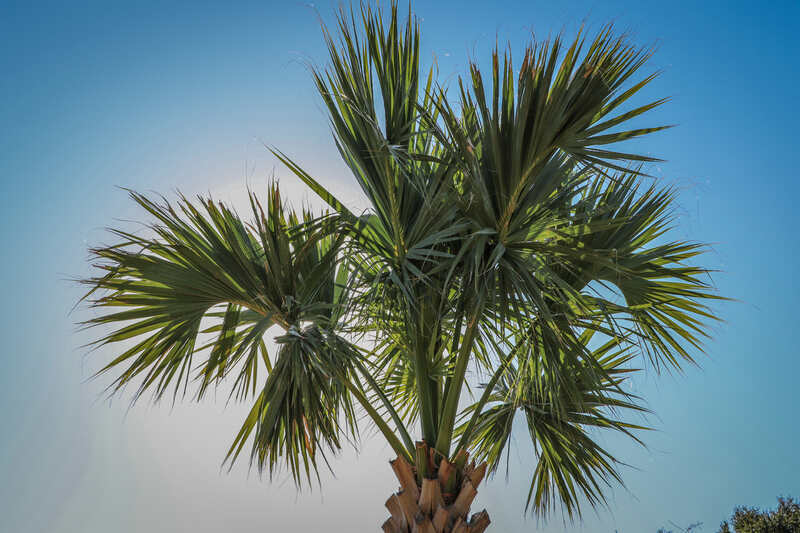
Photo Credit: Pxhere
Chosen as Florida’s state tree, sabal palms are an iconic symbol of the beach. If you are looking for a hardy, tropical tree for your landscape, a sabal palm is perfect because it can last 100 years. Sabal palm is also called cabbage palm because their immature leaves, named heart of the palm, are edible and taste like cabbage.
Sabal palms have large, fanlike leaves and produce white flowers in spring. Palms provide a resting spot for birds, and their seeds make a tasty snack for small critters. Sabal palms are impressively resistant to hurricanes.
Plant your palm trees in a spot with well-drained soil. Sandy or loamy soil is the best type of earth for a sabal palm to thrive in. Sabal palms are a slow-growing plant, so homeowners will have to patiently wait for the palm to sprout up to an impressive height. On the positive side, sabal palms don’t require much maintenance.
Growth habit: Palm
USDA hardiness zone: 7-11
Mature size: 40-50 feet.; can grow up to 100 feet tall
Duration: Perennial
Foliage: Evergreen
Sunlight needs: Full sun to partial shade
Soil preferences: Loamy or sandy
Water needs: Average
Salt tolerance: Moderate; doesn’t like salt near its roots
Wind resistance: High
Potential hazards: Non-toxic
8. Scarlet Hibiscus (Hibiscus coccineus)
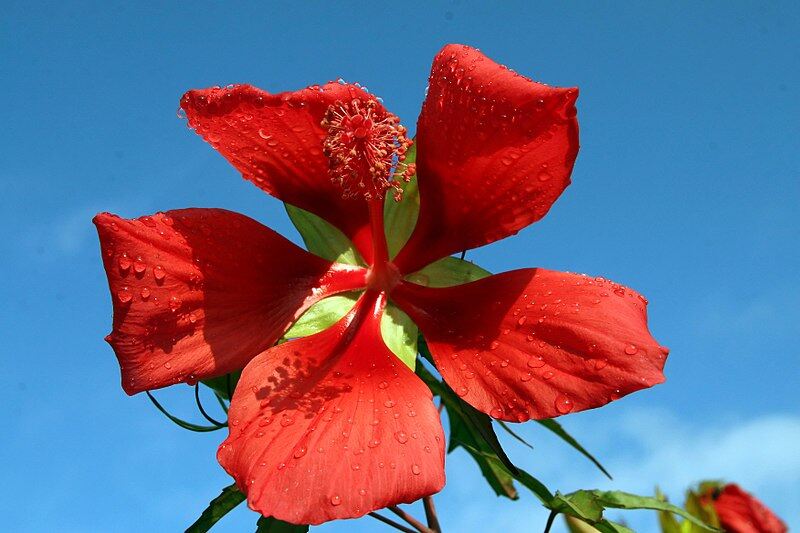
Photo Credit: David J. Stang / Wikimedia Commons / CC BY-SA 4.0
This scarlet-flushed water lover usually lurks in marshes, swamps, or besides streams. Scarlet hibiscus flowers, which look like large crimson pinwheels with five petals, add a touch of red to your landscape in summer. Blooming season starts in early summer and lasts until the fall.
Hummingbirds and butterflies are enticed by the sweet nectar of these flowers, making scarlet hibiscus a great addition to a butterfly garden. Also known as scarlet rose mallow, it thrives in wet soil, so if homeowners have a wet spot in their yard, scarlet hibiscus may be the perfect fit.
Growth habit: Wildflower
USDA hardiness zone: 8-11
Mature size: 3-6 feet high and has a spread of 1-3 feet
Duration: Perennial
Foliage: Deciduous
Sunlight needs: Full sun
Soil preferences: Loamy, moist soils, organic materials, clay, sandy
Water needs: High
Salt tolerance: High
Wind resistance: Low
Potential hazards: Non-toxic
9. Sea Grape (Coccoloba uvifera)
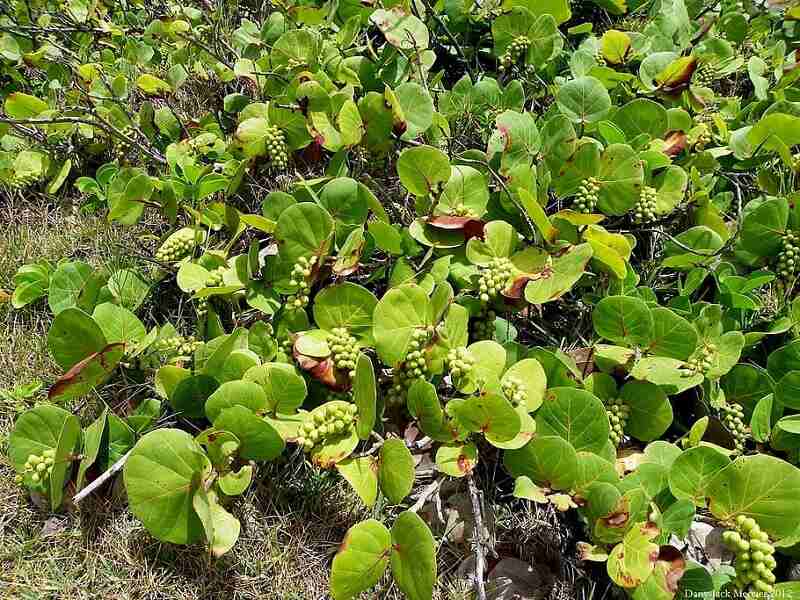
Photo Credit: Pxfuel
It is illegal to harm wild sea grapes, as they are a protected plant species. However, you can bring the shrub-like tree right to your home. Sea grapes don’t produce actual grapes; they derive their name from the purple fruit they produce that strongly resembles grapes in appearance although not in taste.
Sea grape fruit is edible and can be used for making jelly, jam, or wine. Broad, rounded leaves create a place for lizards to hide, white flowers provide delicious nectar to pollinating insects, and purple fruit offers a delicious snack for birds and squirrels. However, the flowers might trigger allergy symptoms.
Usually found growing in sandy beachside soil, sea grapes love oceanside locations. Although it tolerates many types of soil, sea grapes like sandy soils best. The problem with sea grapes is they make quite a mess when they drop fruit all over your lawn. Be prepared to harvest the fruit or deal with cleaning all the fallen fruit out of their lawn.
Growth habit: Shrub/tree
USDA hardiness zone: 10-11
Mature size: 25-50 feet
Duration: Perennial
Foliage: Evergreen
Sunlight needs: Full sun, moderate shade
Soil preferences: Sandy, clay, loamy, well-drained
Water needs: Low
Salt tolerance: High
Wind resistance: High
Potential hazards: Non-toxic. The fruit is edible for people and animals.
10. Sea-oxeye Daisy (Borrichia Frutescens)
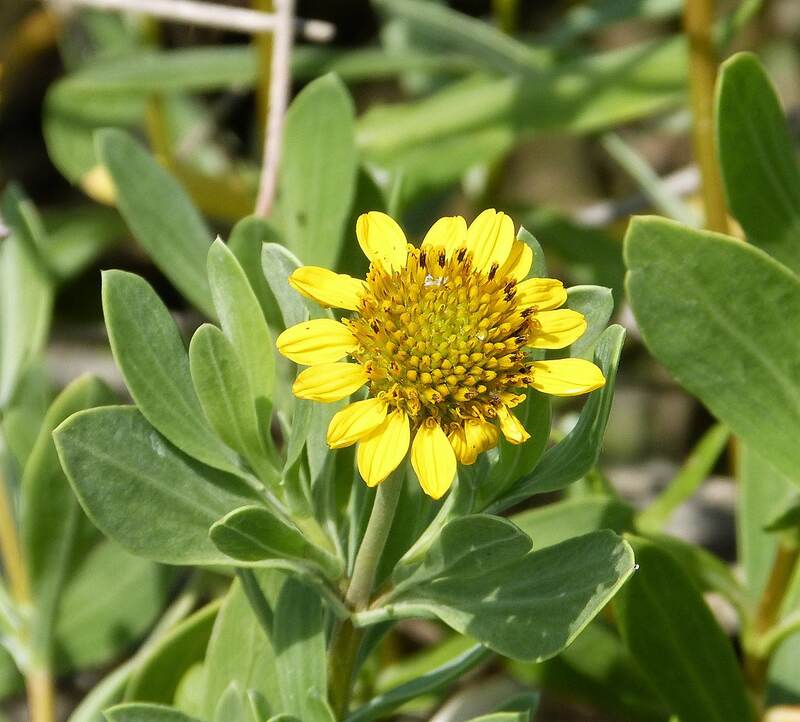
Photo Credit: gailhampshire / Wikimedia Commons / CC BY 2.0
In the Sunshine State you can bring a drop of sunshine right to your yard with the sea-oxeye daisy. These daisies, shrouded with silvery-green leaves, add a colorful touch of yellow to your landscaping and attract pollinators such as bees and butterflies.
Birds love to eat the little black fruits the shrub produces. Sea-oxeye daisies can be used as either groundcover or as stand-alone plants in your landscape. Coastal homes that experience sea spray from storm surges might want to consider installing sea-oxeye daisies, since they have a high salt tolerance.
In the wild, sea-oxeye daisies are usually found dwelling in salt marshes or beach dunes. In your yard, sea-oxeye daisies perform best in sandy or loamy soils that are well-drained and receive a lot of full sun every day.
Growth habit: Shrub
USDA hardiness zone: 8b-11
Mature size: 2-6 feet tall
Duration: Perennial
Foliage: Semi-evergreen
Sunlight needs: Full sun and light shade
Soil preferences: Sandy, loamy, mud, or clay
Water needs: Low
Salt tolerance: High
Wind resistance: Moderate
Potential hazards: Non-toxic
11. Seaside Goldenrod (Solidago sempervirens)
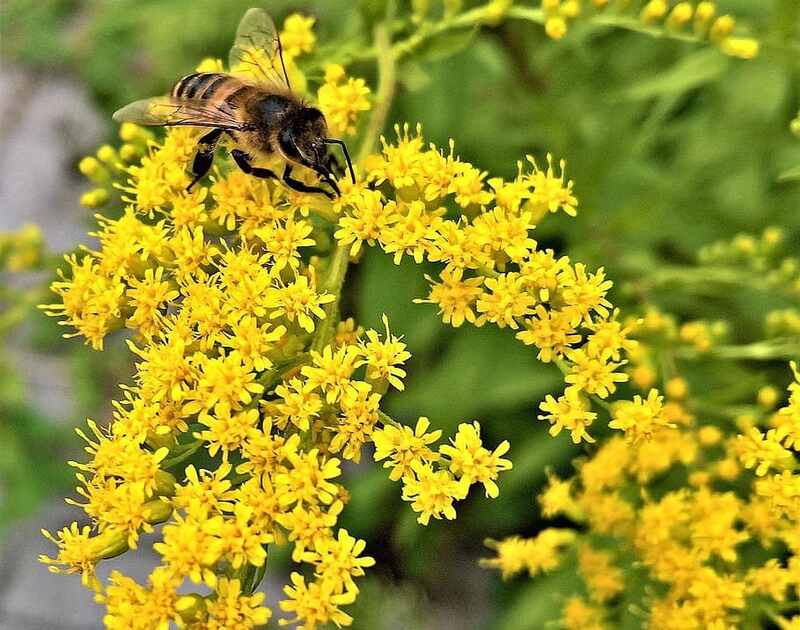
Photo Credit: Pxfuel
If you want to add a cheery touch to your yard, consider seaside goldenrod. The flower’s long stalks burst into color at their tips in an explosion of bright yellow flower clusters. In the wild, seaside goldenrod can be found growing in beaches, dunes, or salt marshes.
Seaside goldenrod is a good fit for butterfly gardens, as their sweet nectar attracts honeybees and butterflies. Its nectar can even be used to make honey.
As its name implies, these flowers can usually be found in areas near the sea such as coastal dunes or tidal marshes. It’s a good plant for sandy soils, though it’s not a picky wildflower and it can grow in a variety of soils.
Growth habit: Herbaceous wildflower
USDA hardiness zone: 8-10
Mature size: 2-8 feet
Duration: Perennial
Foliage: Evergreen
Sunlight needs: Full sun
Soil preferences: Sandy, rocky, clay
Water needs: Low to Average
Salt tolerance: Moderate
Wind resistance: High
Potential hazards: Non-toxic
12. Spiked Blazing Flower (Liatris spicata)
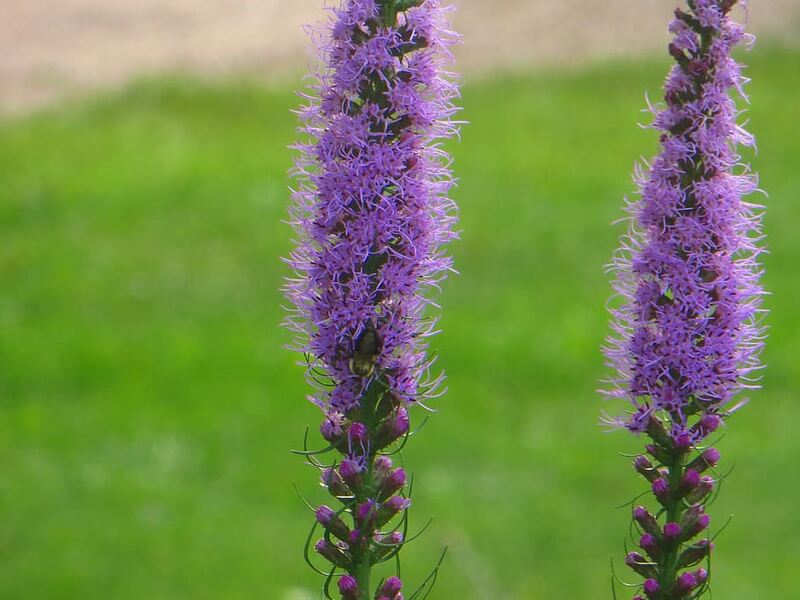
Photo Credit: Pxfuel
Despite the name, the spiked blazing flower is not known for its spiky thorns or sharp edges. The plant is named for its bristly appearance, as both its leaves and the petals have a spiky, sharp look to them.
The spiked blazing flower is known by several names:
- Spiked blazing star
- Dense blazing star
- Dense gayfeather
- Prairie star
Spiked blazing flower is a tall vertical plant, with a long, thin green stalk topped with clusters of purple flowers. Although the flowers are typically a lavender color, they also can be pink or white as well. The sweet nectar or these plants attracts hummingbirds and butterflies.
This drought-tolerant wildflower blooms during summer and early fall, and its leaves turn brown in autumn as the perennial plant goes dormant for the winter. Spiked blazing flowers are susceptible to diseases such as leaf spot and powdery mildew.
Make sure to plant this wildflower in a spot that receives a lot of sun each day. They need to be placed in well-drained soils, since wet or soggy soils can cause spike blazing flowers to rot. It performs best in poor soils.
Growth habit: Herbaceous wildflower
USDA hardiness zone: 3-9
Mature size: 2-6 feet tall, 9-18 inches wide
Duration: Perennial
Foliage: Deciduous
Sunlight needs: Full sun
Soil preferences: Clay, loamy, sandy, organic matter
Water needs: Low to moderate
Salt tolerance: Low; does not tolerate salt or salt spray
Wind resistance: Moderate
Potential hazards: Non-toxic
How to Choose the Best Tampa Natives for Your Landscape
Although native plants grow well in Florida, you can’t place a plant just anywhere and expect it to thrive. Every tree, shrub, and wildflower has different requirements for the type of soil they can thrive in.
Here are things to keep in mind when considering what type of native Florida plants to select for your Tampa yard:
- Sunlight. How much sun does your yard get? The amount of sunlight a plant requires each day will determine where you plant it. If your lawn has a lot of shade, choose plants that thrive in shady spots.
- Soil. Every plant has a preferred type of soil, so check the hardiness zone of your soil to get an idea of what plants will be a good fit for your yard. Don’t forget to consider the moisture levels in your soil, as some plants prefer moist soils while others prefer dry earth.
- Climate. Tampa has mild winters and humid summers, so plants need to be compatible with the local climate.
Tampa is in USDA hardiness zone 9b and 10a. Hardiness zones are used to determine the chances of a plant performing well in a certain location. Before you purchase new landscaping plants for your lawn, be sure to consider what plants will fit with the local hardiness zone.
Tampa has minimum winter temperatures of 25 to 30 degrees Fahrenheit. Tampa has never reached temperatures higher than 99 degrees Fahrenheit, so it has a mild climate year-round.
You also should consider the size of a plant and how much yard space you have. Trees and shrubs take up quite a bit of space as they grow, so make sure that your yard has plenty of space to accommodate such large plants.
For homeowners looking for a wider variety of native species, the Florida Native Plant Society offers a list of native plants on their website for homeowners to browse and learn more information about Florida-friendly plants.
FAQs About Best Native Plants for Tampa
If you want to keep a splash of flora color in your yard year-round, choose plants that flower all year long. With Florida’s mild winters, it is possible for certain types of flowers to bloom even during Florida’s cold season.
Here’s a list of flowers that bloom year-round in Florida:
● Blanket flower
● Blue daze
● Bougainvillea
● Firespike
● Gerbera daisies
● Hibiscus
● Ixora
● Knock out roses
● Lantana
● Mexican heather
● Penta
● Plumbago
● Salvia
● Vinca
Not every plant is completely safe, as some can be toxic to humans and animals. If you have pets or children, you might want to consider avoiding poisonous plants, or at least be aware of which plants may be toxic so you can keep them safely out of the reach of children or pets.
Here are a few of Florida’s poisonous plants:
● Angel’s trumpet
● Azaleas
● Bracken fern
● Brazilian pepper-tree
● Caladium
● Castor bean
● Coral honeysuckle
● Gloriosa lily
● King sago palm
● Oleander
● Poison Ivy
● Poinsettia
● Rosary pea
● Spotted water hemlock
● Yellow allamanda
If you have any of these plants in your landscape, you should be aware that ingesting them can cause serious problems or, in extreme cases, death.
If you want a butterfly garden, choose a selection of native Florida plants to attract pollinators to plant in your yard. Some plants, such as milkweed, can be used as hosts for butterfly eggs and are an essential part of a butterfly’s growth cycle. Certain types of flowers are better for drawing butterflies to their yard than others, so here’s a list of some butterfly favorites:
● Buddleia
● Blue Porterweed
● Butterfly weed
● Coontie
● Coral bean
● Dill
● Firebush
● Firespike
● Gaillardia
● Hydrangea
● Jatropha
● Jessamine
● Lantana
● Milkweed
● Parsley
● Passion flower
● Penta
Flowers that attract butterflies to your yard will usually draw bees and hummingbirds to your landscape, as well.
Where to Find Native Plants in Tampa
Whether you want to add a fiery flare of flowers to your yard or whether you want a long-lived tree to be a part of your landscaping, there are many native Florida plants to choose from. Be sure to ethically source your plants and buy them from a local nursery. Do not transplant them from the wild.
If you are looking for a place to purchase native plants for your Tampa lawn, try checking out these local nurseries for the plants you need:
Tampa frequently experiences hurricanes, so check out our guide on ideas for a hurricane-resistant landscape. Aside from finding the right plants for your landscaping, you should also consider the best grass types for your Tampa lawn or low-maintenance landscaping ideas to minimize the amount of time spent on yard work.
Ready to transform your yard into a beautiful landscape populated with native flora? Let Wikilawn help you find a Tampa landscaping professional to help with your next landscaping and lawn care projects.
Main Image Credit: Seaside goldenrod / Sam Fraser-Smith / Wikimedia Commons / CC BY 2.0

